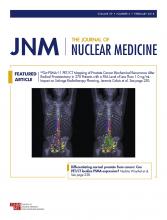Article Figures & Data
Tables
- TABLE 1
Key Reports of PSMA-Targeted Antibody and Small-Molecule Radioligand Therapy for mCRPC
First author PMID Report date Agent n Key efficacy outcomes Key safety outcomes Bräuer 28624848 September 2017 177Lu-PSMA-617 59 ↓PSA in 91% of pts; ≥50% ↓PSA in 53%; median OS 32 wk; PSA decrease after 1 cycle and AP <220 U/L associated with longer OS 2 pts each with grade 3 leukopenia and thrombocytopenia; 12 with new-onset xerostomia Ahmadzadehfar 28488028 August 2017 177Lu-PSMA-617 52 After 1 cycle, ↓PSA in 81% of pts and ≥50% ↓PSA in 44%; 50% of cycle 1 NRs with no response to subsequent treatment; survival of cycle 1 Rs more than twice that of cycle 1 NRs (68 vs. 33 wk) Not reported Afshar-Oromieh 28280855 June 2017 131I-MIP-1095 34 ≥50% ↓PSA in 70.6% of pts; first dose most effective; no association between applied activity and PSA response; median OS 17 mo Measurable leukopenia and thrombocytopenia, significant xerostomia transient but worsening with increasing number of treatments Kratochwil 28408529 April 2017 225Ac-PSMA-617 14 At 100 kBq/kg, duration of ↓PSA <4 mo; antitumor effects additive if therapy repeated every 2 mo Severe xerostomia: dose-limiting toxicity at >100 kBq/kg Rahbar 27765862 January 2017 177Lu-PSMA-617 145 ↓PSA in 60% of pts; ≥50% ↓PSA in 45%; elevated AP and visceral metastases negative predictors of response 10%, 4%, and 3% of pts with anemia, thrombocytopenia, and leukopenia, respectively; 8% with xerostomia Fendler 27683041 January 2017 177Lu-PSMA-617 15 2 cycles of 3.7 GBq (n = 5) or 6.0 GBq (n = 10); ↓PSA in 80% of pts; 67% with PR or SD; pain relief in 70% of symptomatic pts 3 pts with grade 3 events (nausea, leukopenia, anemia) Kratochwil 26985056 August 2016 177Lu-PSMA-617 30 ↓PSA in 70% of pts; ≥50% ↓PSA in 43%; PSA response >24 wk in 8/11 pts receiving 3 cycles 9 pts with worsening of anemia; 8 with leukopenia; 6 with thrombocytopenia Baum 26795286 January 2016 177Lu-PSMA-I&T 56 ↓PSA in 80.4% of pts; ≥50% ↓PSA in 58.9%; 72% PR or SD by CT; 64% PR or SD by 68Ga-PSMA PET 2 pts with transient xerostomia; statistically significant/clinically insignificant decreases in leukocyte and erythrocyte counts Tagawa 23714732 September 2013 177Lu-huJ591 mAb 47 ↓PSA in 59.6%; ≥50% ↓PSA in 10.6% Grade 4 thrombocytopenia in 46.8%; grade 4 neutropenia in 25.5% Milowsky 15173215 July 2004 90Y-huJ591 mAb 29 ↓PSA of 85% and 70% in 2 pts; 6 pts with SD 2 pts with thrombocytopenia and non–life-threatening bleeding pts = patients; AP = alkaline phosphatase; NRs = nonresponders; Rs = responders; mAb = monoclonal antibody; PMID = PubMed identification number; OS = overall survival; PR = partial response; SD = stable disease.
Additional Files
Supplemental Data
Files in this Data Supplement:







